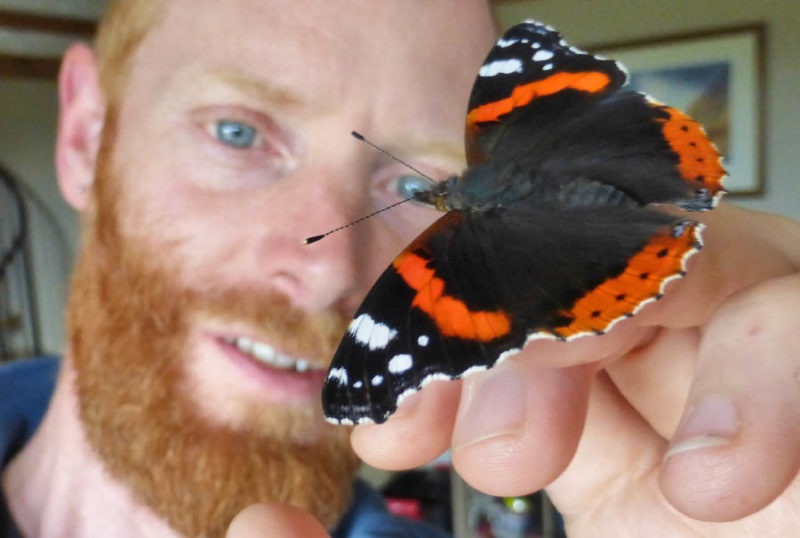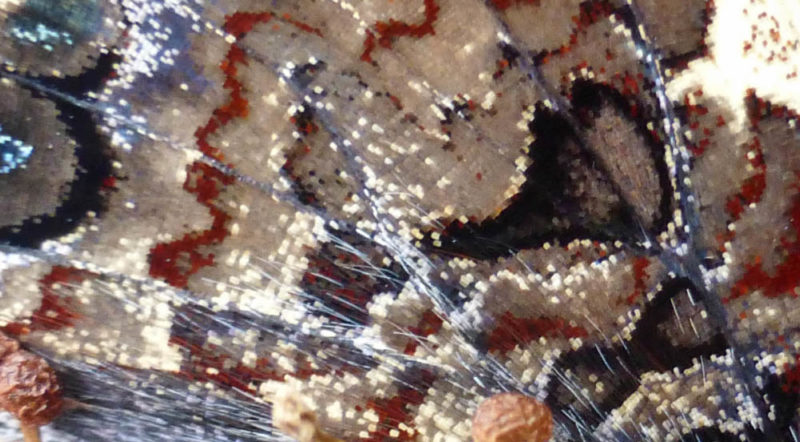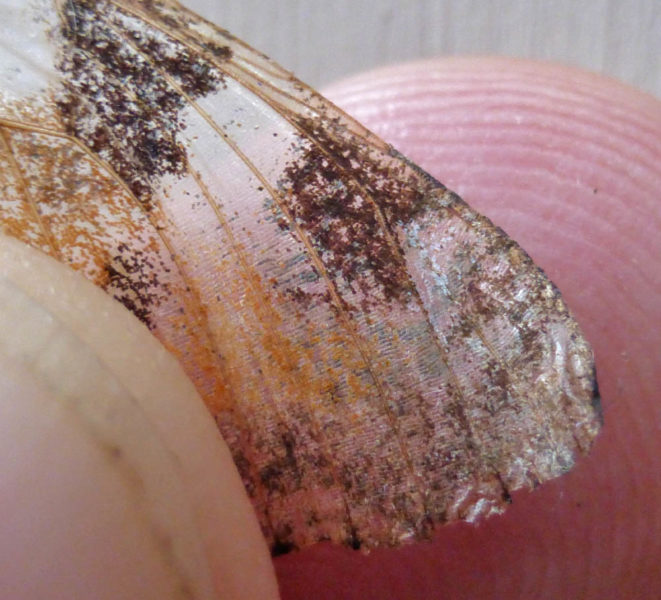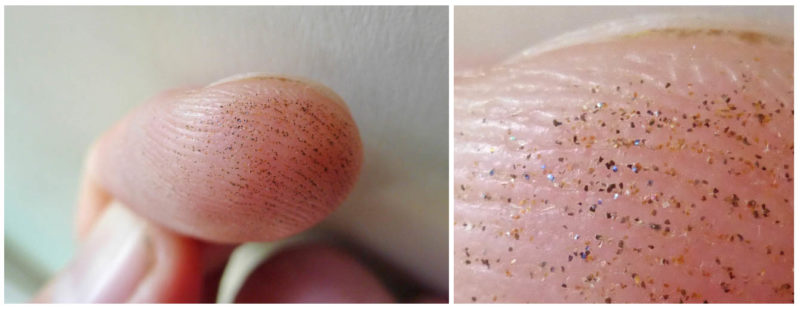
I never actually wanted to keep hold of the butterflies or imprison them as pets when I caught them, rather I just wanted to look at them up close and, if possible hold them in my hand. I loved the feel of those tiny legs walking on my hand and the weird vibration as the butterfly tried to warm itself up before taking to the wing. But I loved even more those astonishing colours, and the ultimate prize in that regard was seeing a large red admiral up close.

A Red Admiral that appeared in my kitchen. All through my life these creatures have been a source of fascination.
However, as mesmerising as a red admiral’s appearance was to the 1980s me, I could never have hoped to get close enough to see what had actually made its stunning markings. Not without a microscope or a magnifying glass, and certainly not without scaring it off in the process. But all the answers I needed were there in front of me long after the butterfly had departed – a shiny dust on my fingers that, unbeknownst to me at the time, held the secrets of not only the butterfly’s exquisite appearance but also its flight, body temperature and its ability to reproduce.
I always noticed the dust but I didn’t know what it was. Truth be told it actually scared me a little when I saw it, for I’d always been told not to touch butterflies because they needed the dust in order to fly. Weirdly I don’t recall ever questioning why this might be the case or what the dust was actually for, in the same way that it wasn’t my place to question why the Darlings needed magic dust in order to fly with Peter Pan from London to Neverland. They just did!
That didn’t stop me from handling butterflies of course, but it did at least mean I did so with care across the subsequent decades, always mindful of the dust problem. But I can’t say I ever really paid the subject much thought thereafter and I therefore remained in blissful ignorance as to the true secrets of a butterfly’s wings until relatively recently. For it is only in the last few years that I’ve possessed technology that allows me to peer that little bit closer. Yep, the humble compact digital camera. You can see so much more if you can get a photograph and then magnify it digitally afterwards, and with warmer and sunnier weather enticing our winged beauties up from the grass and into the sky, that’s something I’ve been doing a lot of in recent weeks.
A beautiful but baffling mosaic
The patterns on a butterfly’s wings might look smooth from a distance as though they’ve been painted with oil or crayons, but a magnified view reveals how the patterns assume a pixelated appearance. Like ancient Roman mosaics the overall image is composed of thousands of tiny coloured tiles, or in the butterfly’s case countless thousands of tiny ‘scales’. This characteristic gives the order to which butterflies (and moths) belong its name – Lepidoptera – meaning ‘scale wing’, and it is these scales that are left behind as a dust-like residue on your fingers after you’ve handled a butterfly or a moth.

A digital zoom shows a butterfly’s wings to be made up of thousands of scales, arranged like roof tiles.
Surprisingly, beneath these scales a butterfly’s wings are actually transparent. Similar to other flying insects they are made from a thin membrane supported by a network of veins, but as many as 1 million scales are attached to that membrane in neat rows that appear very much like overlapping slates on a roof, on both the upper side and the underside of the wings. Many of these scales are individually coloured with normal chemical pigments and this gives butterflies most of their basic colours: namely whites, blacks, browns, reds and yellows, but where these scales are arranged in close proximity they can create the illusion of further shades or hues. However, pigmented scales don’t account for the spectacular iridescent colours, metallic sheens or shimmering effects that many butterflies (including some British species) have.
Such striking effects are produced by a second type of scale called ‘structural’ scales. These are transparent but their surfaces are covered in parallel ridges and trenches, and their internal structure is one of multiple layers separated by pockets of air. As light passes through these scales the different wavelengths bounce off the various microscopic layers, ridges & trenches and are reflected again and again. It is the combination and culmination of all of this light refraction, diffraction and interference that produces such intense colours and iridescence.
Different designs of structural scales produce different colours, meaning you will find a range of designs spread across all butterfly species, but to see truly spectacular iridescence in butterflies you need to head overseas to the tropics. That said, even here in Scotland you can see it to some extent. The eye spots on the wings of the much-loved Peacock butterfly are produced by structural colouration, but more impressive are the vivid electric blue and shimmering green produced by the Common Blue and the Green Hairstreak respectively.

Structural colouration in Scottish butterflies – Left: peacock. Centre: green hairstreak. Right: common blue.
The complexity and intricacy of it all is as baffling as it is beautiful, but the patterns painted by the tiny scales aren’t purely for our viewing pleasure. Butterflies use their markings for camouflage or to warn-off predators, either by using colours more typically associated with toxicity or poison or by using patterns that look like another creature entirely. But the markings also help butterflies identify different species and sexes, which is obviously important in reproduction.
Butterfly scales can be oblong, tear-drop shaped or hair-like in appearance but while their basic shapes differ from species to species they are all made from a substance called chitin, which is also found in the exoskeletons of crustaceans. This makes the scales strong and durable for their size, giving protection to the less durable wing membrane underneath, lending support to the wings when the butterfly is in flight and even, it is suggested, acting as miniature solar panels by absorbing the much-needed warmth that butterflies must have in order to fly.

Close up of a long dead small tortoiseshell wing. You can see how the wing itself is transparent where the scales have fallen off.
Diminishing scales
Strong, durable and important as they are, butterflies only get one set of scales in their lifetime, so the readiness with which they accumulate on your fingers does make you wonder if they’re dislodged a bit too easily. But while it might seem like a design flaw just imagine how useful it would be to have a detachable outer coating if you flew into a sticky spider’s web. The comparison that springs to mind is when you were a kid being chased by the school bully, him grabbing your arm as you tried to escape but you managing to wriggle out of your blazer and leave him standing there holding said clothing instead of you. Erm… I’m sure I can’t be the only person who did that?
There is of course strength in number. I only had one blazer but a butterfly has hundreds of thousands of scales, and when you’ve got that many you can afford to lose a few. Losses are however inevitable given the hardships that these tiny creatures have to endure from day to day – wind, rain, abrasion, attacks from predators, not to mention flapping their wings several times a second or migrations that cross international borders. Were they to live to be 20 years old then the steady attrition of scales would clearly be a problem. It could affect their ability to warm themselves, to avoid danger and even to attract a mate, but because they live only for days, weeks or at the most, months, the losses they experience in their short lives aren’t too problematic. So it’s not the end of the world if you inadvertently get that magic dust on your hands, but you should still be careful because those scales could get the butterfly out of a tight squeeze one day!

Magic dust on my finger from a small tortoiseshell butterfly. A close up shows it is made up of scales.
Banknotes and paint
I’m sure it will come as no surprise to learn that scientists have already identified the vast potential of the structural colouration found in butterfly scales. The technology is already being mimicked to protect against counterfeiting in banknotes, as existing chemical pigments and dyes favoured by forgers simply cannot replicate the appearance of structural colour. Those pigments (including those found on pigmented butterfly scales) also fade over time, and it doesn’t matter if it’s the paint on a wall or a car or whether it’s the dyes in clothing, they will eventually fade or bleach and look washed out.
Structural colouration however, of the kind produced by butterflies and other iridescent insects will remain bright and vivid as long as the microscopic structures that generate it remain intact. Science is therefore daring to envisage a time when we can produce environmentally friendly paints and dyes that never fade and are not toxic. Progress is being made but for now the everlasting paints remain firmly in the realms of science fiction, as it requires nano-technology that is currently way too ‘nano’ to produce. Watch this space though…..
Get your own close up photo of butterfly wings
The good news here is that extreme close ups are no longer confined to professional photographers or scientific laboratories with powerful microscopes. Pretty much every single one of us now has a portable microscope with us at all times – ie a mobile device that invariably includes an okay camera, a surprisingly decent macro (close up) function and the ability to zoom in afterwards.
You still need to get very close to the butterfly, however, in order to take a macro photograph – inches away rather than feet. So when you’ve spotted a butterfly at rest, try to approach it side-on (preferably aiming for whichever side is lit by direct sunlight) so that you don’t have to adjust your position to see its wings once you reach it. You need to be VERY slow in your approach though with no sudden movements, keeping low to the ground and being careful not to let your shadow fall on the butterfly. When I do this I make sure my camera is already switched on and held in front of me as I approach.
You’ll look a tad ridiculous I admit, but at least that way you’ll already be in the photographing position as soon as you get close enough to the butterfly, rather than risking scaring it away once you get there by reaching for your camera or fiddling with the buttons.
Assuming you’ve reached your target without scaring it off, then snap away! Some devices automatically switch to macro mode when they figure out what you’re up to but check beforehand in case it is something you need to switch on yourself. Also, if your camera or phone lets you focus using a single point in the middle of the frame then switch that function on too, otherwise don’t worry about it. Take as many pics as you can because some will undoubtedly be slightly blurred, then just pick the sharpest of the bunch (delete the rest) and use the zoom function to magnify the wings. Even an average smart phone will be able to capture the individual scales.
Finally, as I’m sure many of you already know, it can be insanely difficult to sneak up on a butterfly and it will take many attempts to do so. Keep trying though, and take advantage of cooler, duller weather when they’re less likely to flee your approach.
Good luck!

